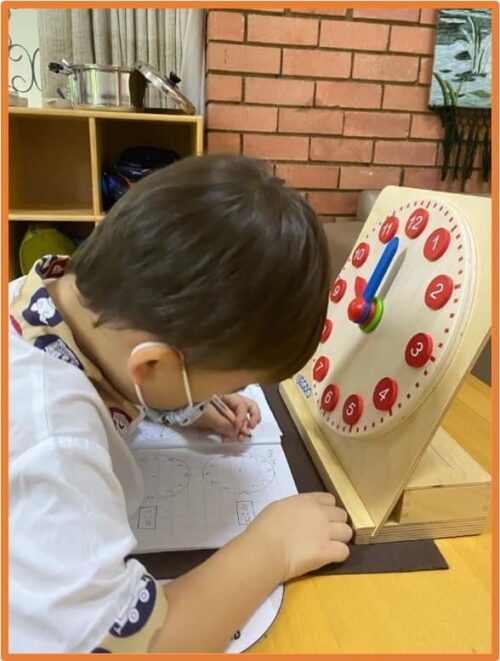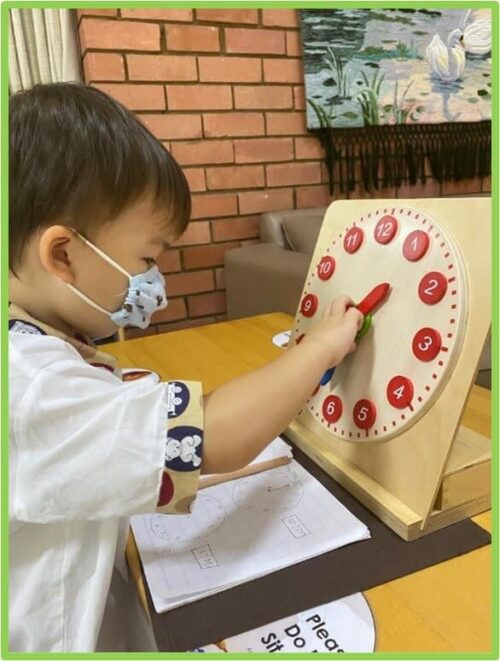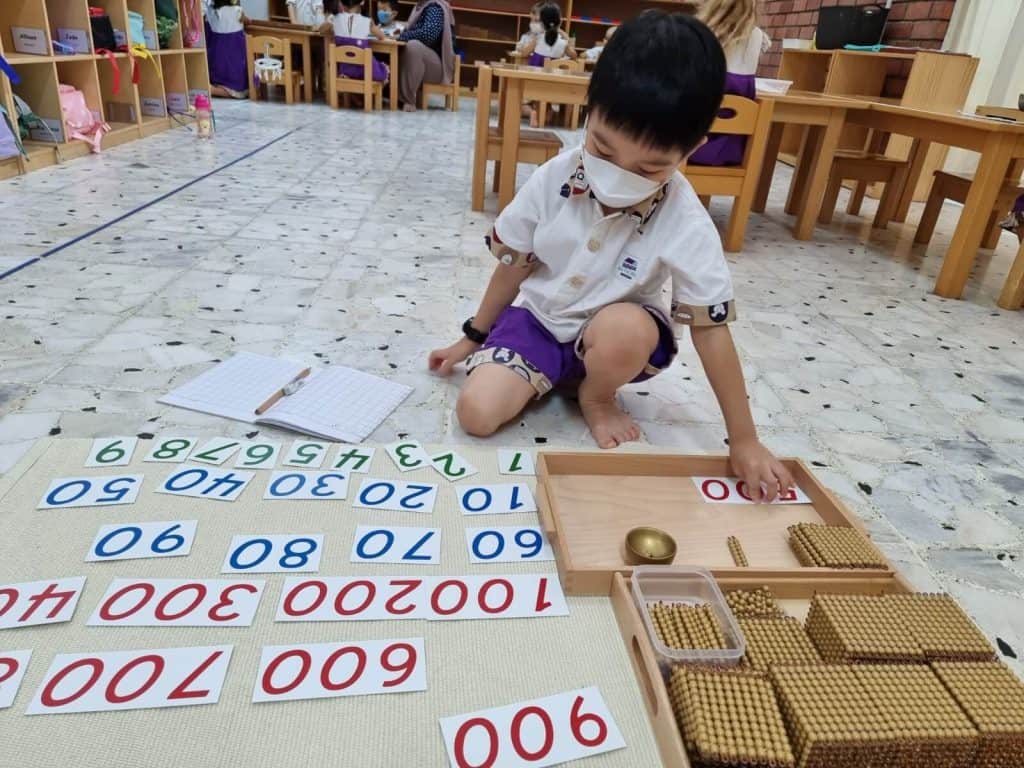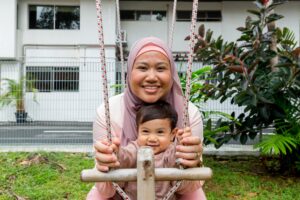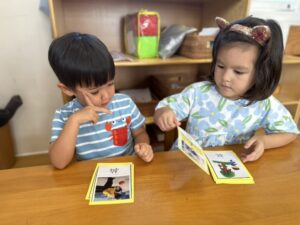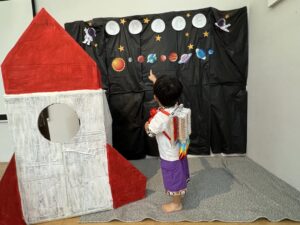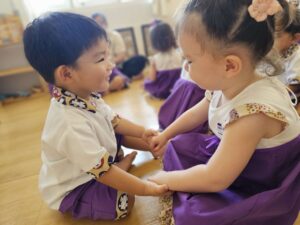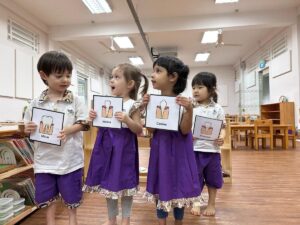“Children display a universal love of mathematics, which is par excellence the science of precision, order, and intelligence.” –
Dr. Maria Montessori
4 Beautiful Locations Islandwide
The Montessori Approach in Mathematics
One of the questions we get all the time from prospective parents is how the Montessori education prepares their child for the Primary 1 Ministry of Education Singapore (MOE) Mathematics.
The quick answer is that Montessori Mathematics materials are nothing short of amazing.
By graduation, Kindergarten 2 children at HOTH will have already completed half of the Singaporean Primary 1 MOE Mathematics syllabus.
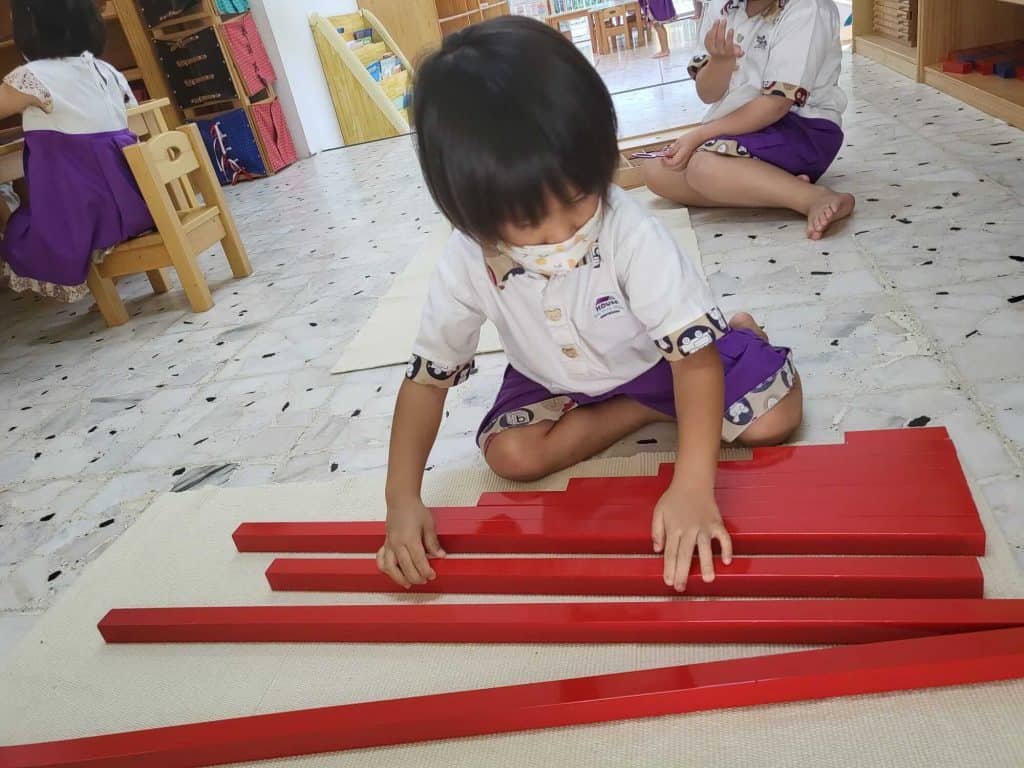
Dr. Maria Montessori believed that children were born with a ‘mathematical mind’, a core foundation of human intelligence and she defined it as a natural tendency for precision, orientation, and order, usually demonstrated in older children as capacity for logical, systematic thinking.
The daily activities and sensorial materials in the Montessori classroom explore these mathematical qualities and provide a strong foundation for later systematic learning of arithmetic, geometry, and algebra.
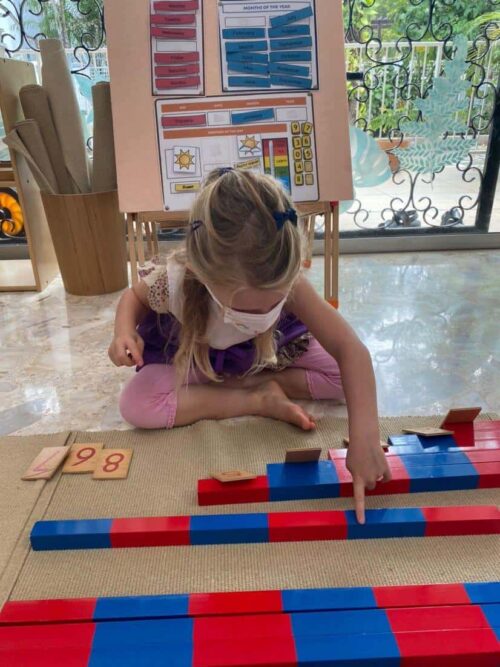
Our Montessori Math Materials
The Mathematics materials in a Montessori classroom are a natural progression from the exercises of Practical Life and the Sensorial materials.
The child’s previous manipulations with these materials would have developed their concentration, which is one of the key essentials to the logic thinking and problem-solving skills required in Mathematics.
Sensorial Activities
The sensorial activities are specifically designed to isolate qualities like form, quantity, dimensions, etc. This gives the child a chance to deal with isolated qualities physically.
For example, with the Red Rods, the child learns about length; with the Pink Tower, he learns about sizes, etc.
The “isolation of stimulus” (Standing, 1959: 161) helps the child to focus on the quality and through working with these materials, the child is able to see a pattern in the differences.
Further sensorial activities will also require the child to do simple matching exercises where he perceives the similarities and differences of the objects, like the tactile tablets, thermic tablets, etc.
These perception of similarities and differences will develop the child’s sense of perception which will help to lay the foundation for their future Mathematics work.
They are able to bring order and system into the various sense impressions that they perceive.
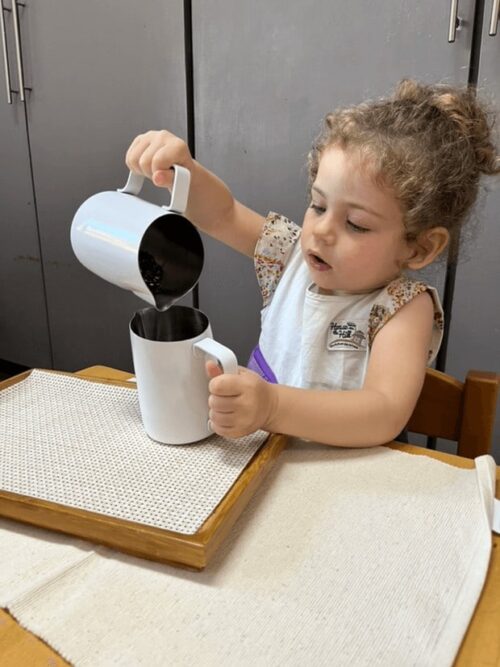
Practical Life Activities
In addition, through working with the Exercises of Practical Life, they experience other basic skills like estimation and exactness in perception, which are also essential skills for Mathematics.
For example, when a child pours water from a jug to cups of different sizes or into graded cups, they have to estimate how much to pour and to ensure that there is sufficient water in each container.
Another exercise of Practical Life would involve the child sorting the different coloured buttons its respective bowls. The child uses their visual perception to an exact precision.
Thus, when a young child works with the exercise of the Practical Life and Sensorial Activities, they are indirectly working to prepare themselves for Mathematics work.
Young children learn through active participation, which is through their sense and muscular system. “The child’s intelligence can develop to a certain level without the help of his hand. But if it develops with his hand, then the level it reaches is higher” (Montessori, 1999:139).
Thus, a young child may be able to pick up the early concepts of Mathematics through abstract methods, but it would be with much difficulty. Often, if the learning of such facts and skills were to start in its abstract form, it would drown the child’s joy of learning.
These same skills are also harder to achieve if they are introduced later in a child’s development. If children are exposed to Mathematics materials in their early years, they can easily assimilate many facts and skills of Mathematics operations.
Because Maria Montessori believed that “the hand is the chief teacher of the child” (Wolf, 1995: 4), she allowed the child to learn the basic concepts materials.
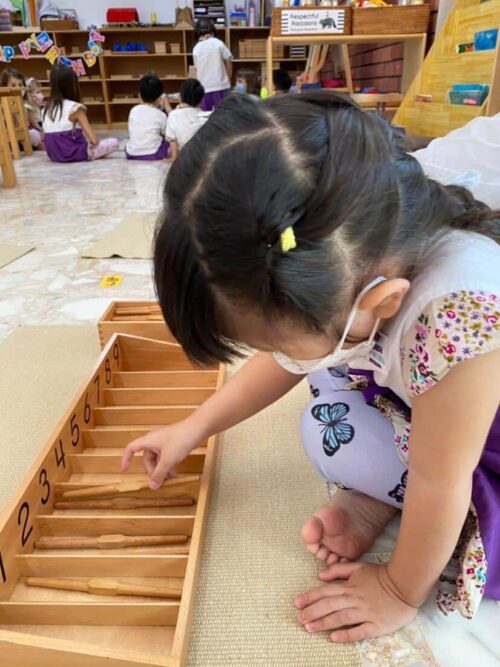
The Mathematics materials are designed “not to store a quantity of knowledge in the child, but to satisfy his innate desire for learning and the development of his natural powers”.
The concrete Mathematics materials represent all types of quantities. “A child not only sees the symbol for 1,100 or ½ he can also hold each of the corresponding quantities in his hand.
The child is constantly using his hands to manipulate the materials by working “these operations in the concrete, first, until the very essence of the ‘rule’ becomes absolutely clear to him”. He will then move on to the abstract level where he wishes to write out the operation. At this stage, he acquires an intrinsic preference for mental calculations.
Through the extensive Mathematics activities conducted in school, children in HOTH are given the head start to help them prepare for Primary 1 Mathematics.
Appendix:
Comparison chart of the Primary 1 MOE Mathematics syllabus and how Montessori Mathematics provides the foundational skills for students to transition confidently and comfortably
Comparing the Primary 1 MOE Syllabus vs Montessori Mathematics
| Primary 1 MOE Mathematics | Montessori Mathematics |
|---|---|
| NUMBERS AND ALGEBRA SUB-STRAND: WHOLE NUMBERS (Numbers up to 100) | THE SEGUIN BOARDS SMALL NUMERICAL RODS, ADDITION & SUBTRACTION STRIP BOARD |
| Here are a few activities that Primary 1 children will focus on 1. Counting to tell the number of objects in a given set - Play games using dot cards, picture cards, numeral cards and number-word cards etc. for number recognition and comparison 2. Number bonds for numbers up to 10 - Use number-bond posters and make number stories to build and consolidate number bonds for number up to 10 | 1. Number Rods (Fixed Quantity Counting) 2. Sandpaper Numerals 3. Spindle Box (Loose Quantity Counting) 4. Cut-Out Numerals and Counters (Odd & Even) 5. Short Bead Stair (Addition 5 and below & 10 and below) (Subtraction 5 and below & 10 and below) |
These Montessori activities introduce children to numbers one through ten. The number rods, spindle and cards & counters help to reinforce the names of the numbers in association with their quantities and written symbols and also one-to-one correspondence.
Additionally, children are also introduced to the colours of individual bead bar in the short bead stair and this prepares them for either addition and subtraction or Seguin Boards exercises.
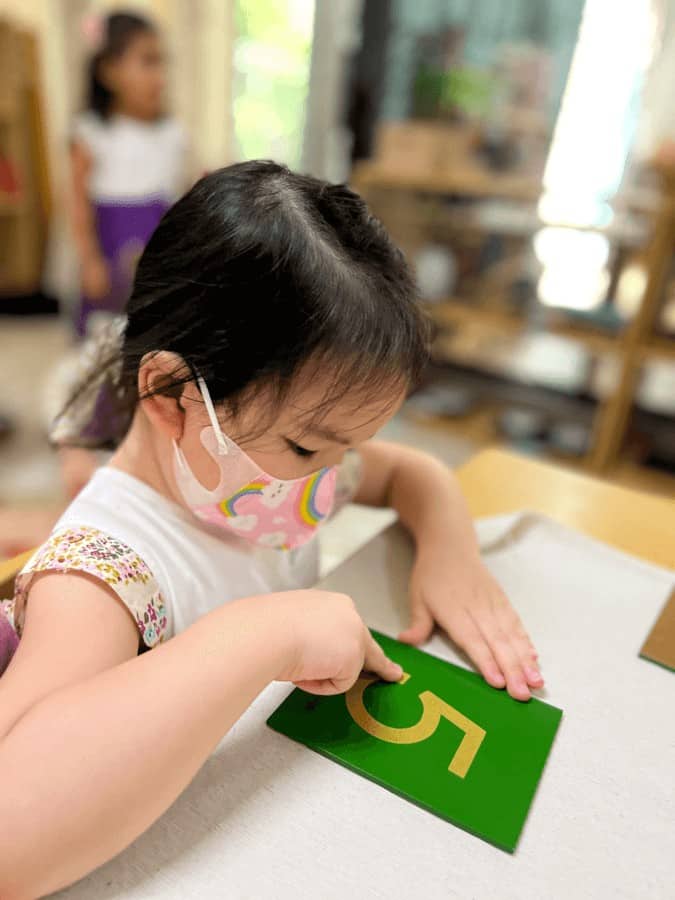
Sandpaper Numerals
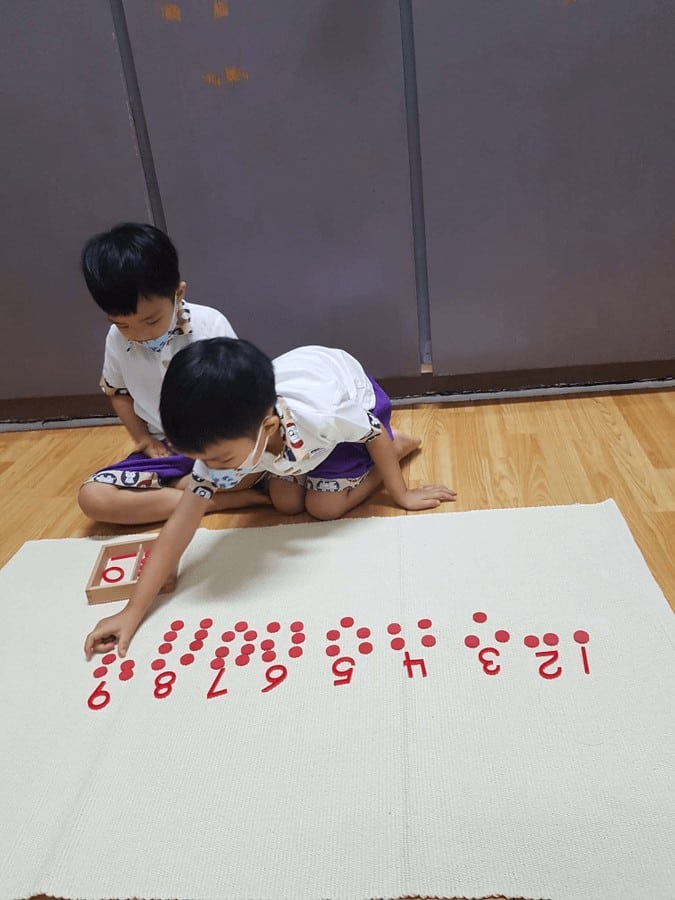
Cut-Out Numerals and Counters
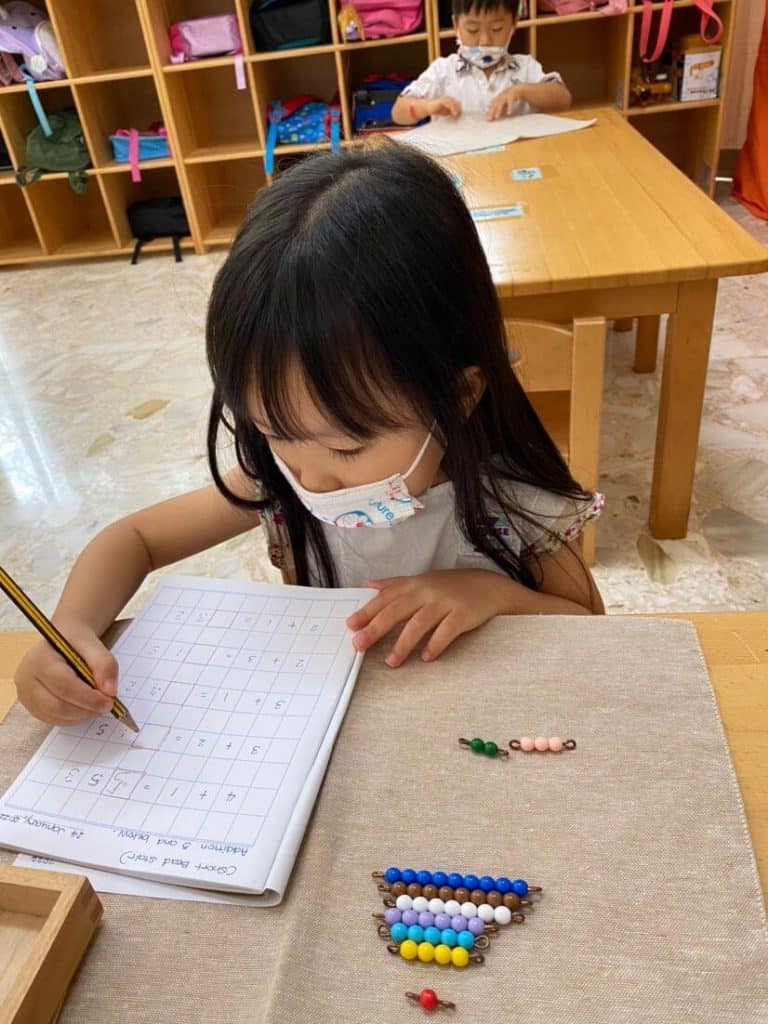
Addition using Short Bead Stair
Numeration
| Primary 1 MOE Mathematics | Montessori Mathematics |
|---|---|
| NUMBERS AND ALGEBRA SUB-STRAND: WHOLE NUMBERS (Numbers up to 100) | THE SEGUIN BOARDS SMALL NUMERICAL RODS, ADDITION & SUBTRACTION STRIP BOARD |
| Number notation, representations and place values 1. (tens and ones) through activities 2. Using concrete objects to : make a group of ten and count from 10 to tell the number (less than 20) : make groups of ten and count tens and ones to tell the number (more than 20) | 1. Teens Beads (Seguin Board A) - Concrete and Abstract 2. Tens Beads (Seguin Board B) - Concrete and Abstract 3. Small Numerical Rods (Addition & Subtraction) 4. Addition and Subtraction Strip Board |
These activities include Linear and skip counting within 11 to 99. Teens and tens boards are used to demonstrate linear counting in association with the golden beads that represent quantity along with their numeral symbols.
By using the Small Numerical Rods and Addition & Subtraction Strip Board, the children will further enhance their learning concept of addition and subtraction.
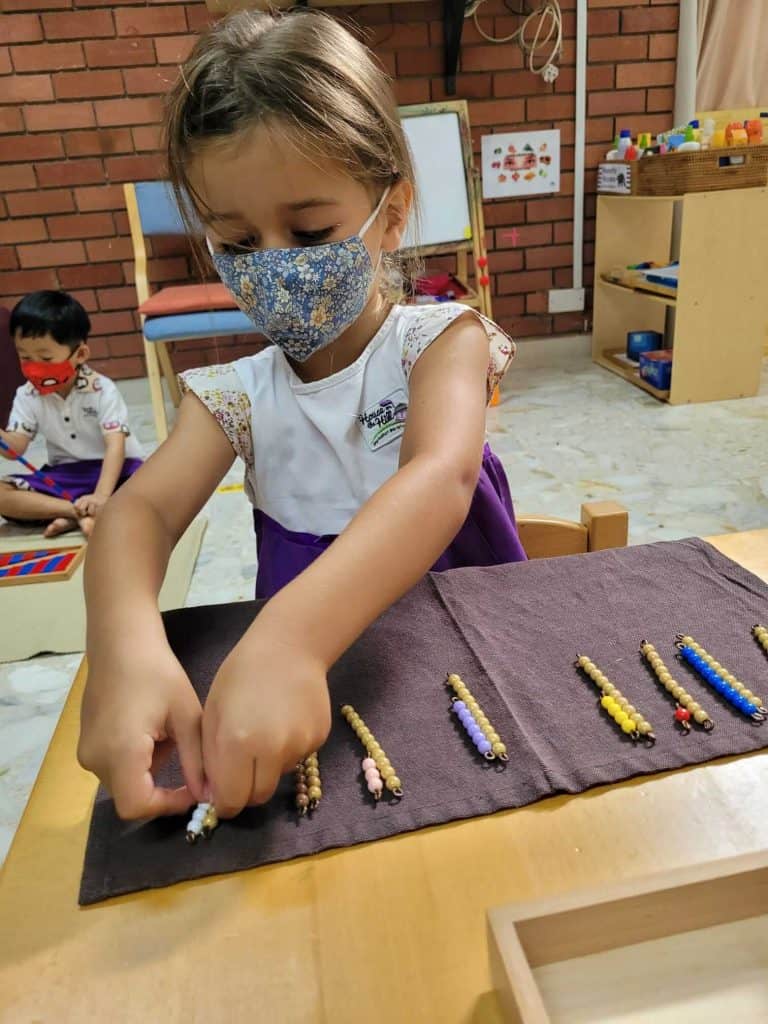
Teen Beads (Seguin Board A)
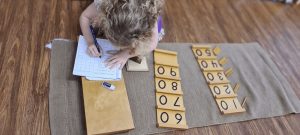
Tens Beads and Board (Seguin Board B)
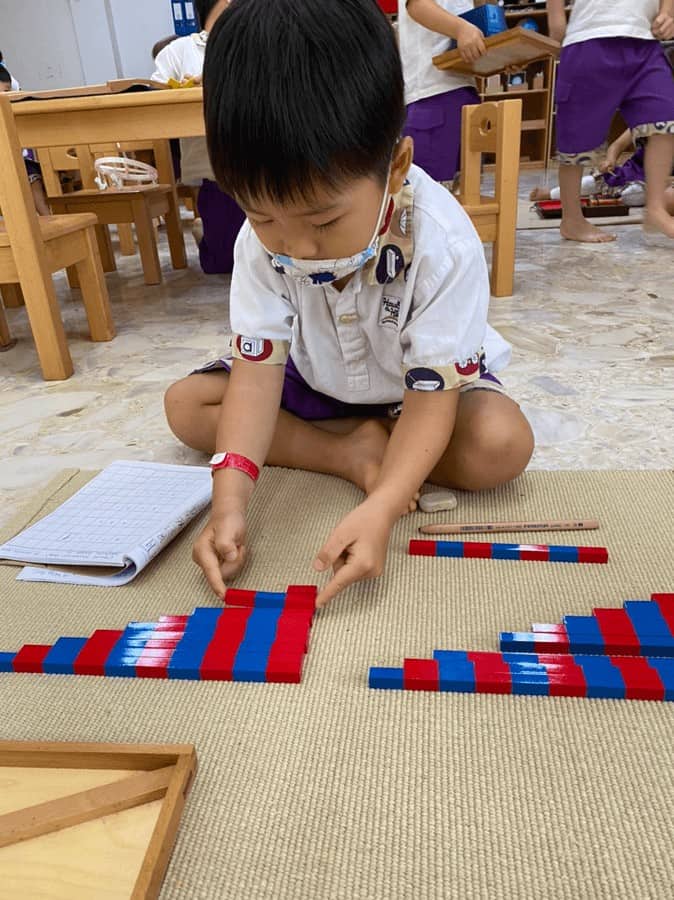
Small Numerical Rods
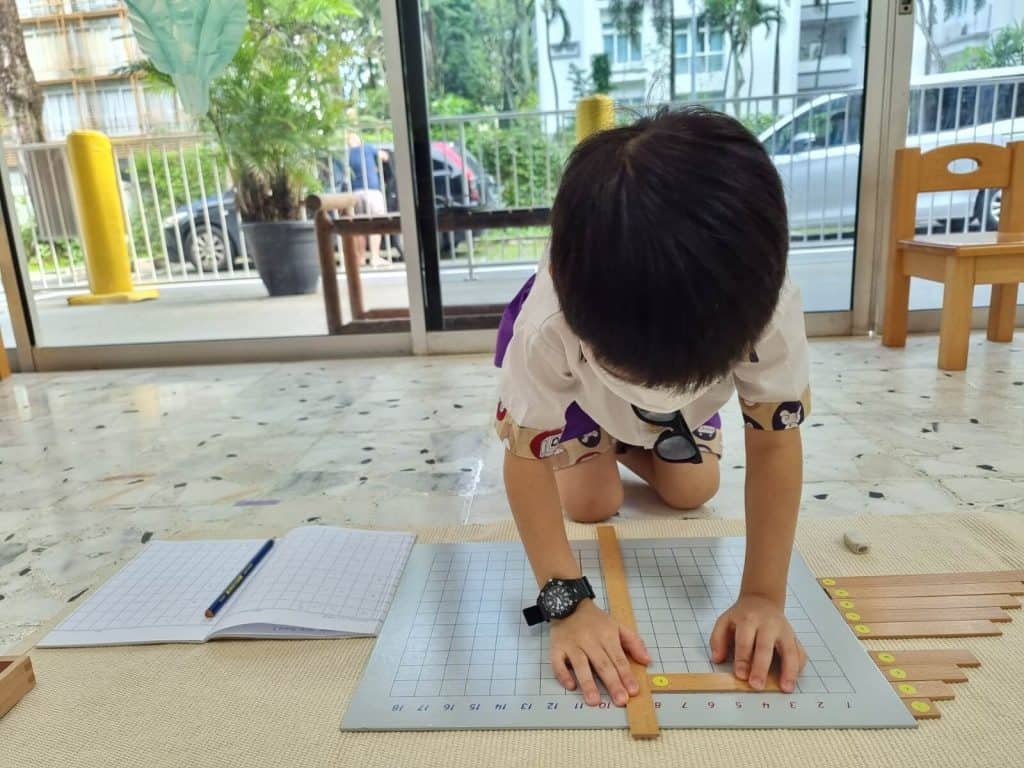
Addition Strip Board
Mathematical Operations
| Primary 1 MOE Mathematics | Montessori Mathematics |
|---|---|
| SUB-STRAND: WHOLE NUMBERS Addition, Subtraction, Multiplication and Division | DECIMAL SYSTEM and GROUP OPERATIONS with GOLDEN BEADS |
| - adding and subtracting within 100 - make addition and subtraction stories using concrete objects/pictures - use the base-ten set to illustrate the standard algorithms for addition and subtraction of 2-digit numbers - concepts of multiplication and division - multiplying within 40 - dividing within 20 | 1. Names of Quantities (Concrete and Abstract) 2. Counting through 1-1000 (Beads and Cards) 3. Vertical Addition and Subtraction without changing - Hundreds/Tens/Units 4. Vertical Addition & Subtraction with changing - Hundreds/Tens/Units 5. Problem Sums Addition and Subtraction without Changing, with statement - within 50, within 100 6. Problem Sums Addition and Subtraction with Changing, without statement - within 50, within 100 7. Multiplication Board - Within 20, 40 8. Unit Division Board |
Children are introduced to the Decimal System in these activities.
Dr Maria Montessori demonstrated perfectly her deep understanding of how children learn to understand and associate quantities and mathematical language whilst manipulating objects.
The bead materials and the associated cards for each category (units hundreds, tens and thousands) focus on the hierarchy and the functions of the decimal system.
Using the units, tens, hundreds and thousands as represented by materials such as unit beads, ten bead bars, hundred squares, thousand cubes, children have an opportunity to experience and compare the sizes and weight of the Golden Bead materials. This creates a hands-on learning experience that teaches place value up to 9,999.
They are also used for decimal operations involving addition, multiplication, subtraction and division sums using golden beads with small and large number cards.
The concept that ten units can be changed to a ten bar, ten-ten bars can be changed to a hundred and ten hundreds can be changed to a thousand is the central idea behind these operations.
Measurement and Geometry
| Primary 1 MOE Mathematics | Montessori Mathematics |
|---|---|
| MEASUREMENT AND GEOMETRY | MEASUREMENT AND GEOMETRY |
| 1. Length - (measuring & comparing the length of objects in non-standard units) 2. Time - (Telling time to the hour/half hour) by telling time from a clock face and relate time to the events of a day using ‘clock’ and ‘half past’ 3. 2D Shapes - (Identifying, naming and describing basic shapes such as rectangle, square, circle, triangle) | 1. Length 2. Weighing and Mass 3. Capacity and Volume 4. Time 5. Area 6. 2D and 3D Shapes (through Sensorial materials) 7. Money |
Children are also taught to read time such as half past, quarter past etc. through working with the clock material.
They are also taught about money concept through interactive games and role-playing activities.
Additionally, Mathematical concepts are also taught through working with the Sensorial materials whereby they explore Perceptions of Differences, Perception of Differences and Similarities: Simple Matching to more Complex Matching and Graded Series of ten.
When children explore the variety of perceptions, they are also learning the concepts such height, visual discrimination, size, length etc. Children develop their mathematical mind through this process of materialised abstraction, whereby they can truly understand the meaning of the concepts.
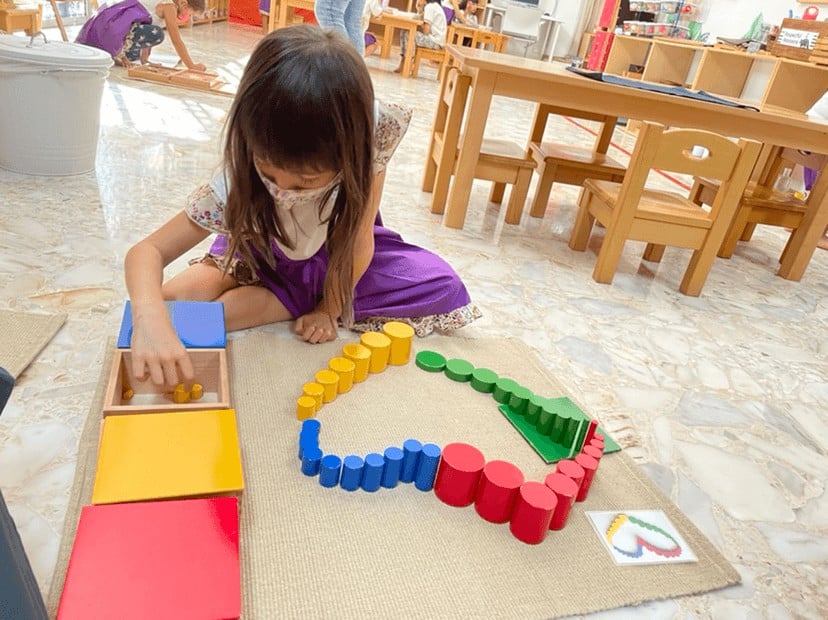
Perception of Differences: Knobless Cylinders
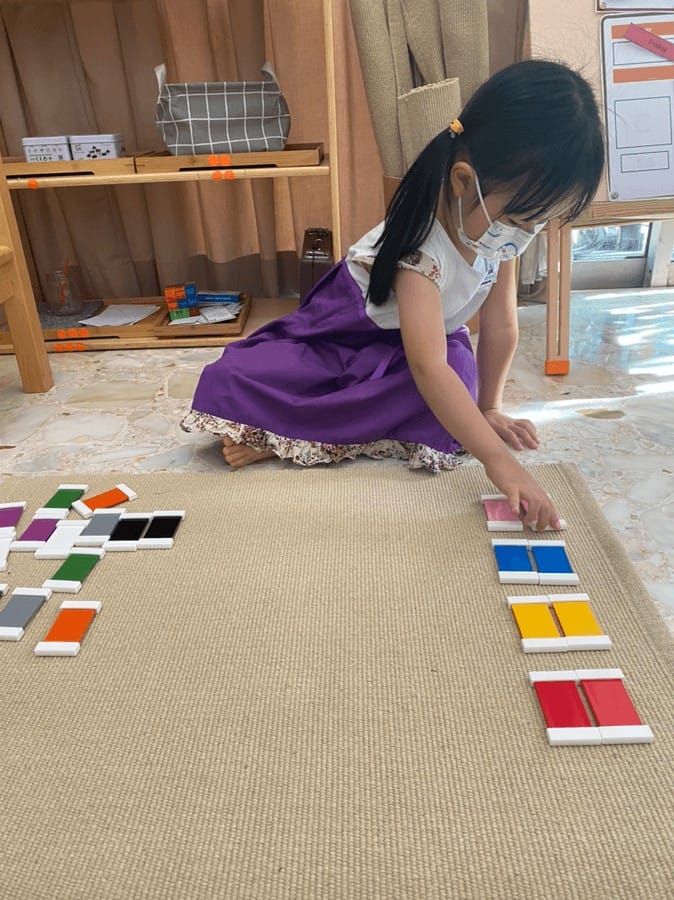
Perception of Differences and Similarities: Simple Matching: Colour Box 2
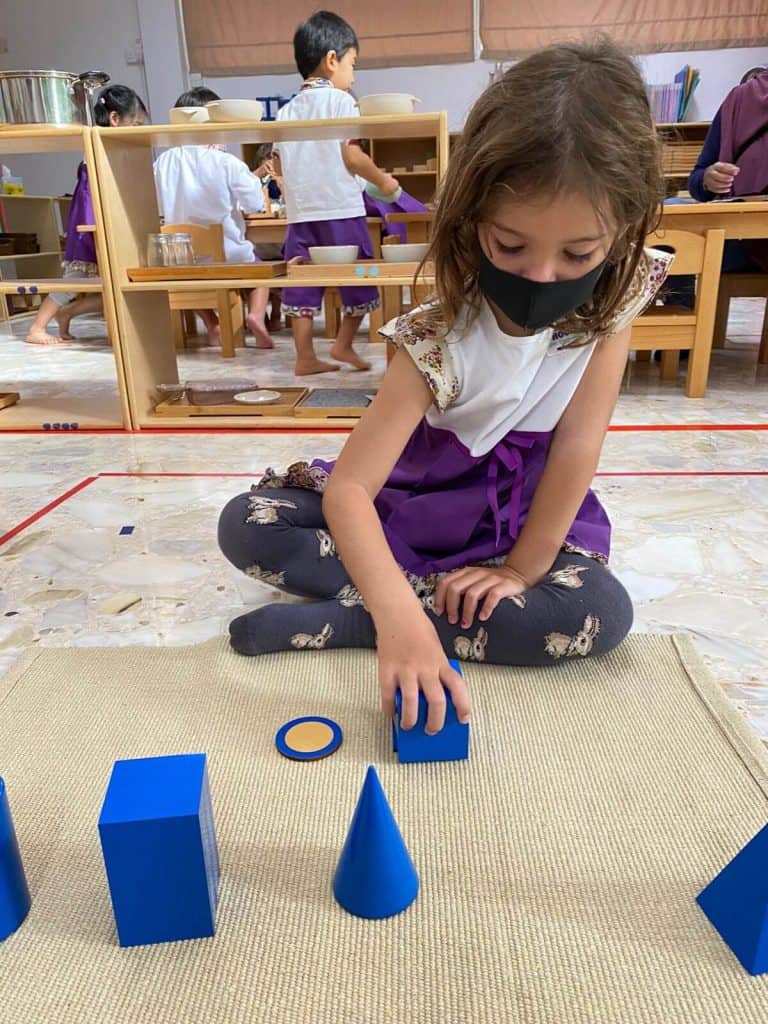
Perception of Differences and Similarities: More Complex Matching: Geometric Solids with Base
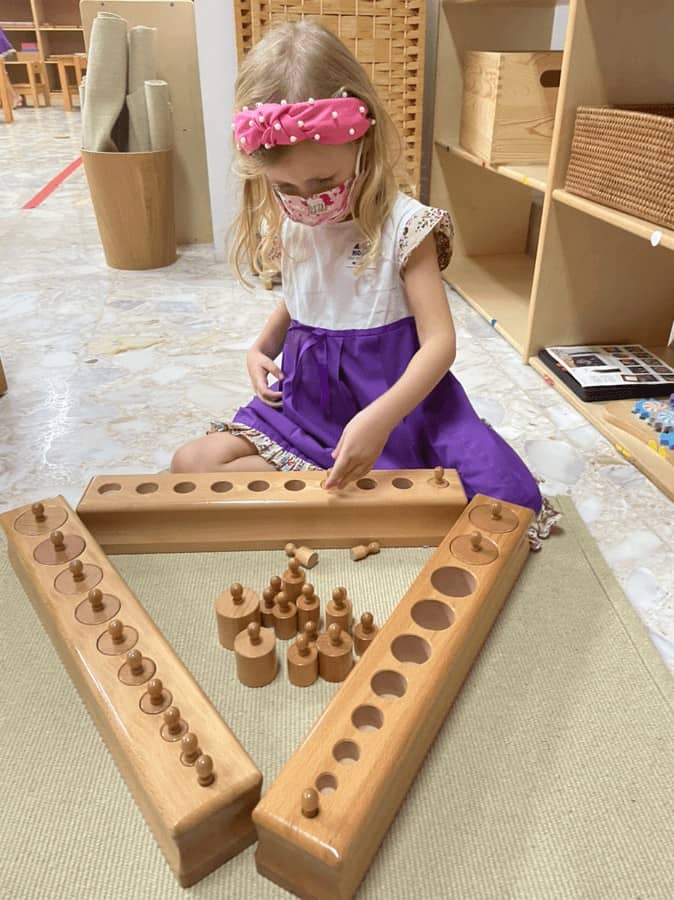
Graded Series of Ten: Knobbed Cylinders
